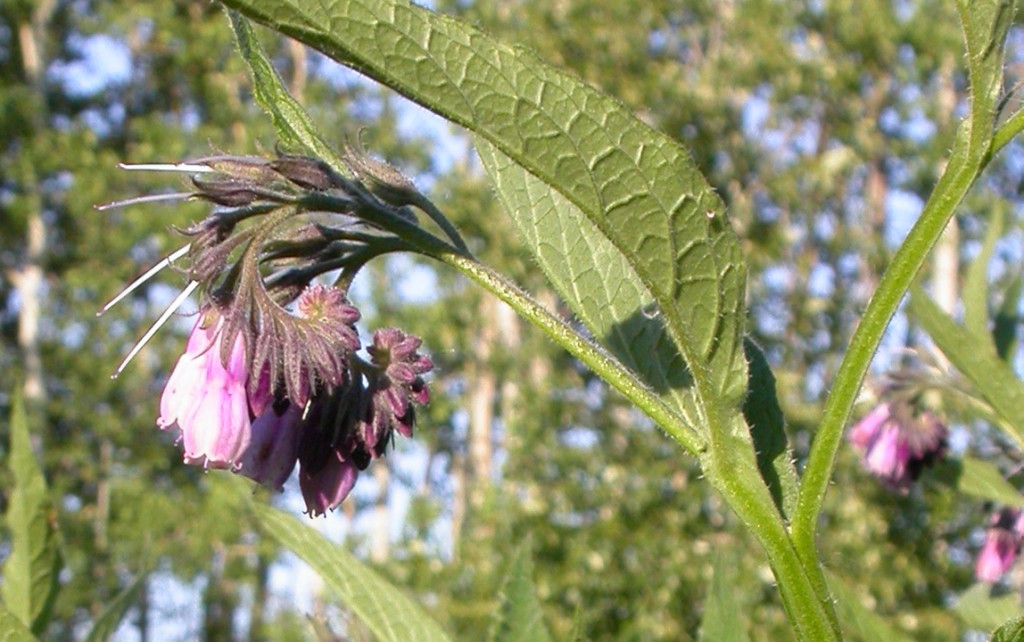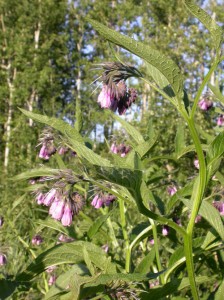Comfrey Symphytum officinalis

- in a clinical study comfrey ointment used for ankle sprains was significantly better than diclofenac gel (Voltaren), a non-steroidal anti-inflammatory drug. Arzneimittelforschung. 2007; 57(11):712-6
Speed wound healing – a clinical study showed that wounds healed faster with a topical application of a comfrey product (aerial parts) and that there tended to be better effects if the person was older. There were no adverse effects reported. Wien Med Wochenschr. 2007;157(21-22):569-74 https://tinyurl.com/ybdx2xe
Osteoarthritis – a clinical study using an ointment made with comfrey root showed significant improvement for osteoarthritis sufferers. It reduced pain, increased mobility, and therefore improved quality of life. Phytomedicine. 2007 Jan;14(1):2-10. https://tinyurl.com/yzrxrhf
Back Pain
- Comfrey ointment was significantly helpful in helping with back pain. Phytother Res. 2013 Jun;27(6):811-7. doi: 10.1002/ptr.4790.
- “Comfrey root extract showed a remarkably potent and clinically relevant effect in reducing acute back pain” according to this double-blind, placebo controlled study. Br J Sports Med. 2010 Jul;44(9):637-41. doi: 10.1136/bjsm.2009.058677
Myalgia
- a clinical study demonstrated significant improvement for patients with upper and lower back pain. Adv Ther. 2005 Nov-Dec;22(6):681-92
- Bruises, sprains, muscles & joints – not only did this clinical study demonstrate the effectiveness of comfrey, for painful conditions such as bruises, sprains and distortions, as well as pain in muscles and joints, compared to non-steroidal anti-inflammatories (NSAIDs), but the patients were also able to reduce or discontinue their use of existing NSAIDs. Fortschr Med Orig. 2002;120(1):1-9
Osteoarthritis
- This Review of the effects of comfrey covers its effectiveness for osteoarthritis, back pain, blunt injury to ankle, and other musculoskeletal conditions. Wien Med Wochenschr. 2013 Feb;163(3-4):58-64. doi: 10.1007/s10354-012-0162-4
Toxicity
The toxicity debate over comfrey is ongoing. Some herbalists use it without worry while others don’t. It is interesting to note that the negetive toxicity studies done on comfrey tend to be done using very high doses, or do not represent the effect that oral ingestion or topical use would have. For example injecting phytochemcals from this plant directly into the blood stream would not be the same as eating the leaves of this plant.
- This review talks about the DNA damage, cancer developement, and hepatotoxic effects of comfrey. J Toxicol Environ Health B Crit Rev. 2010 Oct;13(7-8):509-26.
- This study using rats found that a comfrey extract was protective against neoplastic liver lesions. Evid Based Complement Alternat Med. 2010 Jun;7(2):197-202. doi: 10.1093/ecam/nem172.
Wound Healing
- Comfrey leaves demonstrated wound healing ability, especially in regards to swelling and collagen deposition, in the form of a lotion made from them. Pharmazie. 2012 Apr;67(4):355-60.
- A study on children with blunt trauma demonstrated effectiveness of a topical preparation of the areal parts of comfrey. Arzneimittelforschung. 2012 Jun;62(6):285-9. doi: 10.1055/s-0032-1308981
- Another Review on the affects of comfrey for blunt trauma pain, inflammation, swelling, and arthritis. Phytother Res. 2012 Oct;26(10):1441-8. doi: 10.1002/ptr.4612.


